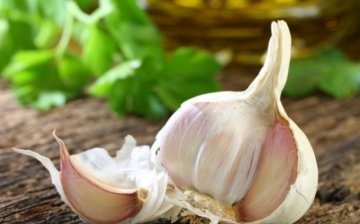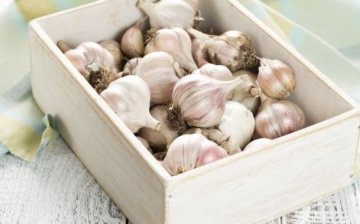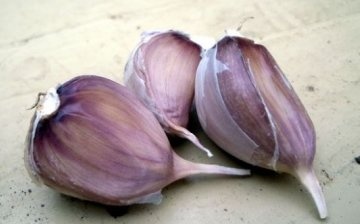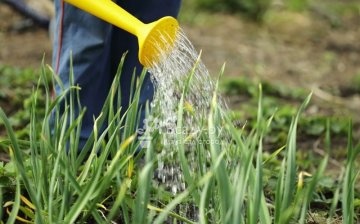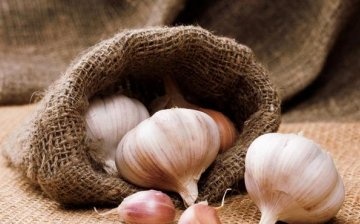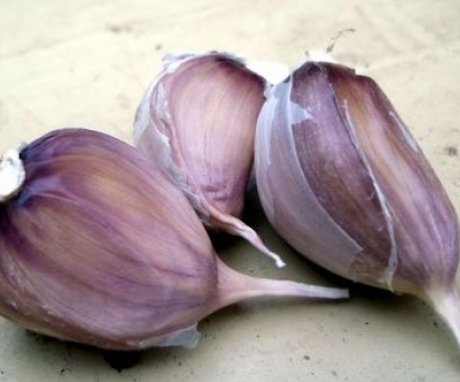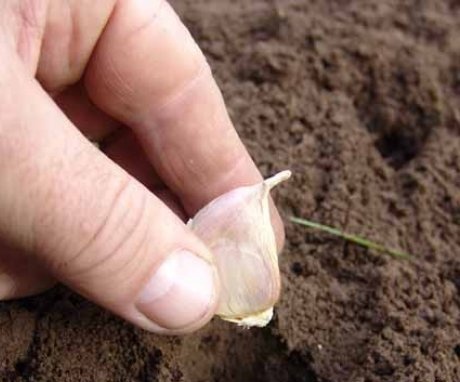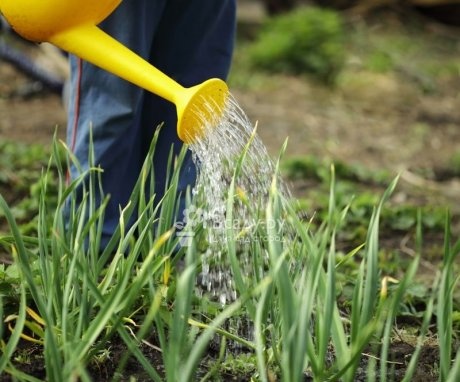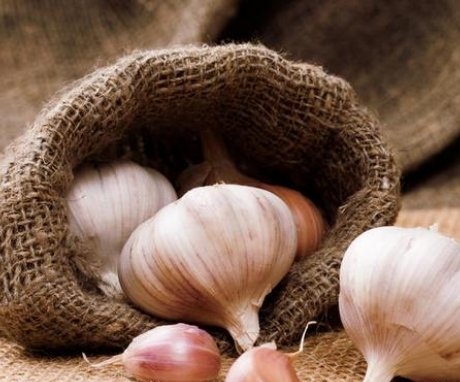Gardener tips: the better to process garlic before planting
Garlic - an ancient plant that has been eaten as a spice since time immemorial. Garlic is actually a type of onion.
Content:
- Garlic: classification and varieties
- Site preparation and garlic processing
- Planting garlic
- Garlic care
- Cleaning and storage
Garlic: classification and varieties
Garlic is a bulbous plant. It is usually grown as an annual. But, if it is not dug up in the summer, it can grow into a bush. Each of the cloves will sprout and release a stem. Of course, such garlic does not form a head, and its feather will be thin and low. Such bushes can be planted in spring or cut feathers for salad.
Garlic is a delicious and healthy plant. Young leaves are used in spring, chives are used all year round. Salting and pickling vegetables is hard to imagine without this spicy plant. Fungicides, which are in its composition, successfully fight bacteria. All varieties of garlic can be divided into groups according to several parameters.
By planting time:
- Winter
- Ardent
By the presence of an arrow:
- Shooting with large teeth.
- Not shooting. It lasts longer, has up to 20 small teeth.
By appointment:
- Canteens (usually spicy arrowheads).
- Industrial (usually peninsular, non-shooting).
Nowadays, about 600 varieties of garlic are grown in the world. The most popular and common with us:
- Gribovsky 60 - winter, forming an arrow with red scales. Zubkov 7-11.
- Gribovsky jubilee - winter arrow with purple scales. The weight of one head with 11 teeth is 40 g.
- Otradnensky - winter shooter with pink scales. Zubkov up to 6 pcs.
- Danilovsky local - winter, does not form an arrow. Cloves up to 11, lilac scales.
- Poretsky is local.
Garlic is grown from the cloves that make up the head. They are separated shortly before planting. The denticles of many varieties are very large. Sometimes the head can be divided into just 4 parts. Winter varieties, on the arrow of which small bulbous cloves are formed, can be grown from them. This method is often more cost effective.
Garlic grows well in sunny areas.
The soil prefers sandy loam or loamy, rich in organic fertilizers, without a close occurrence of groundwater. The acidity index should be 6.0-6.5. Garlic grows poorly on wet, heavy soils. There the feather takes on a light green color. At the same time, the plant needs sufficient moisture. With its lack, the feather of garlic turns white, bends over.
Site preparation and garlic processing
Peas are good precursors for growing garlic. cucumbers, zucchini, siderates... Do not plant it after Luke, carrots, potatoes, tomato.
Preparatory activities:
- They begin to prepare the garden at the end of summer. Make organic, phosphorus and potash fertilizers. If the soil is acidic, lime it by adding dolomite flour or slaked lime. The introduction of peat makes it looser. If the soil is sandy, clay and peat are added.
- Then the site is dug up and leveled with a rake. For disinfection, some vegetable growers advise spilling the prepared area with a solution of copper sulfate. For this, 1 tbsp. l. the funds are dissolved in a bucket of water and added 1 liter per 1 m2.Cover it with plastic wrap, which is not removed until the garlic is planted. But this will not give much effect.
Closer to planting, the heads are disassembled, the chives are prepared, being careful not to damage them. You can take average in weight and more than average. Placement in a row (outer or inner) does not matter. Small teeth are not taken, they have a small supply of nutrients.
How garlic can be processed:
- Sometimes it is advised to immerse the cooked cloves in a saline solution in order to protect the garlic from onion flies. For 1 liter of water, take 1.5 tbsp. tablespoons of salt. Stand for 2 minutes. But experts do not advise using substances containing chlorine to care for garlic, including NaCl salt, potassium chloride, ammonium chloride. It is especially harmful to water the area with saline. This can lead to salting of the soil.
- Some sources advise treating the cloves of garlic with a solution of copper sulfate. The cooked teeth are immersed in it for 1 minute, washed with water. Opponents of this method argue that the potassium permanganate solution acts on pathogens in a concentration that is harmful to plant tissues. They advise using a fungicide for treatment, for example, a dressing agent "Maxim".
- Hot garlic is soaked in warm water overnight. You can add a handful of nitroammophoska to it. When preparing planting material for ardent varieties of garlic, the chives that were stored in the room are placed in the refrigerator for a month. Before planting for a day, soak in a mixture of potassium humate and wood ash (2 tbsp. L. Per liter of water). Potassium monophosphate can be used. These solutions will help restore moisture lost during storage. After processing, they are ready for planting.
- If it is not possible to plant ardent garlic in early spring, cold root formation is carried out. To do this, the teeth are placed in a cold, damp place (wrapped in a damp cloth and hidden in the refrigerator). After the roots grow 1 cm long, they are planted in the ground.
When preparing baby bulbs, the largest specimens are selected. After they are removed from the arrows, they are dried and stored until planting.
Planting garlic
It is necessary to plant winter varieties of garlic a month before frost. During this time, he must take root in order to survive the winter. This is usually the last week of September to mid-October. At the same time, baby bulbs are planted. If the garlic is planted too early, it will sprout, extend the arrow, and freeze and disappear in winter. An additional batch of fertilizers is introduced: humus, nitrophosphate, superphosphate and wood ash. It can be replaced with Kalimaga (40 g). They dig up the soil, level it with a rake.
The cloves are planted at a distance of 7 cm from each other in a row, row spacing is 25 cm. Can be planted according to the 10x10 scheme. Immersion depth up to 8 cm (size of two teeth). Children are planted thicker, after 2 cm, between rows of 10 cm. The planting depth is 3 cm. If there is not enough planting material, small cloves can also be planted separately from large ones. They can make good planting material for the next year.
Ardent varieties are planted in the spring as early as possible.
The signal will be budding on the birch. There should be no water or excess moisture on the site. Before planting, the soil is dug up. Then the prepared cloves are planted to a depth of 4 cm. It is better to mulch the plot with straw. In the spring, it will retain moisture on the site, and in the winter it will protect it from frost. Fresh grass is not advised to use, because it can serve as a source of fungal diseases.
Garlic care
The garlic beds are weeded regularly and weeds are removed. During the loosening of the soil, the air permeability of the soil increases. Top dressing of garlic can be omitted. But if it grows slowly, you can feed it 2 times a month with a solution mullein or chicken droppings... A liter of manure is infused in a bucket of water for 10 days, then diluted in a ratio of 1:10. They feed the third time when the head size reaches 3 cm.
Water as needed in May and June no more than once a week.
In July - only during severe drought. After watering, the soil is loosened (if there is no mulch in the aisles). Arrows, which throw out some varieties to form seeds, take a lot of strength and nutrients from the plant. Therefore, they are plucked before they begin to bloom. Gently pull the arrow with both hands so that it comes off as low as possible, inside the stem. If this is not done, the teeth will grow very small. Several plants can be left in order to collect baby seeds.
Garlic can be affected by fungal diseases:
- Downy mildew (peronosporosis). Peronosporosis appears as pale green spots on the leaves, which then turn gray with a purple tint. Prevention - keeping the beds clean, good lighting of the site.
- Black mold. Black mold appears when dry garlic is stored at high temperatures. Prevention - good drying of heads before storing.
- Cervical rot. To prevent the garlic from disappearing from cervical rot, the plants are well dried. First 12 days at temperatures up to 26 ° C, then 3 days up to 36 ° C. For storage, you can process the heads with chalk.
- Fusarium.
For the prevention and control of fungal diseases, plants are treated fungicides... To improve adhesion, pour in 1 tsp. liquid soap.
The main pests of garlic:
- Nematodes - small worms that get inside the plant. As a result of their vital activity, the bottom of the head of garlic is destroyed, and it becomes unsuitable for storage. You can notice the nematode by the yellowish lines on the leaves. Getting rid of a nematode is difficult. A good way of prevention is to change the landing site. Garlic is returned to its original place in the 4th year after cultivation. Liming also helps to cleanse the area from nematodes. It is carried out no later than a month before planting.
- The onion fly is dangerous with its larvae. They take root inside the head of the garlic, which leads to decay and loss of yield. To scare her away from the garden, sprinkle the aisles with wood ash (100 g), mixing it with a spoonful of ground pepper and tobacco dust. Once every 5 days, the soil is loosened to a depth of 3 cm. You can spray with an aqueous solution of this mixture, filled with boiling water and infused for 3 days. Prevention - early planting of ardent varieties of garlic.
Cleaning and storage
The garlic is harvested after the feather has turned yellow and died. The head wrapper also changes color. Harvesting time usually falls in mid-July-early August. It depends on weather and climatic conditions. If you are late in harvesting and leave the ripe garlic in the soil for a while, the heads may turn black and break up into separate cloves.
Garlic is dug up along with the roots, dried in the fresh air in a place protected from direct sunlight. When the stem and roots are completely dry, cut them off, leaving a few millimeters on both sides.
They are placed in boxes or boxes so that fresh air is constantly supplied to the heads.
The temperature in the room should not be high, otherwise the teeth will dry out quickly. In winter, it can be stored in the attic, well wrapped in an old blanket. In the spring, as soon as the frosts leave, they remove the shelter so that the cloves do not germinate. Can be stored at 18 ° C.
More information can be found in the video:



